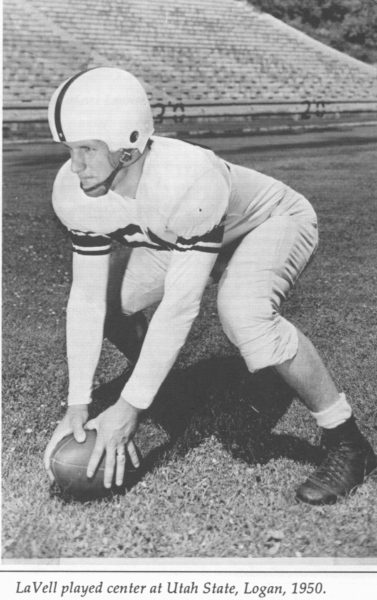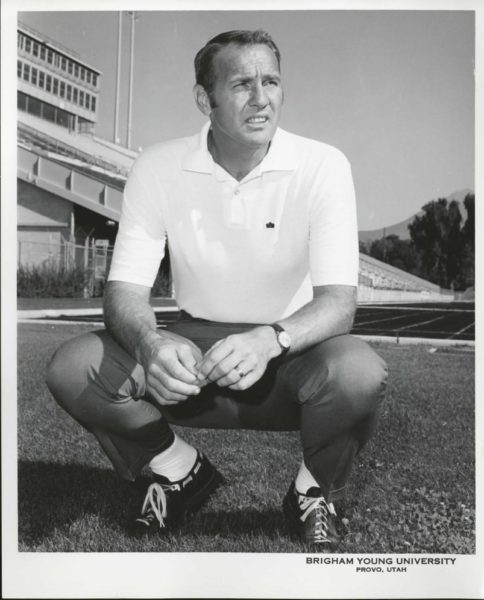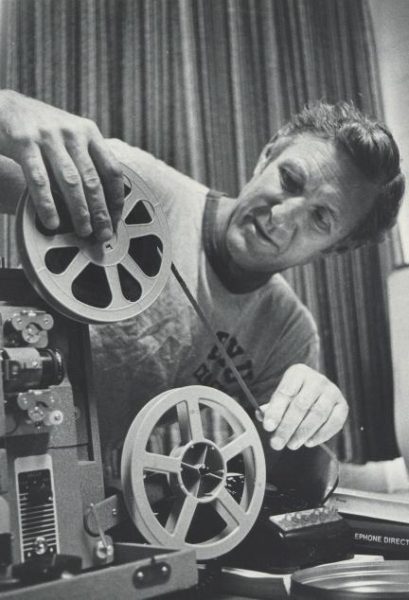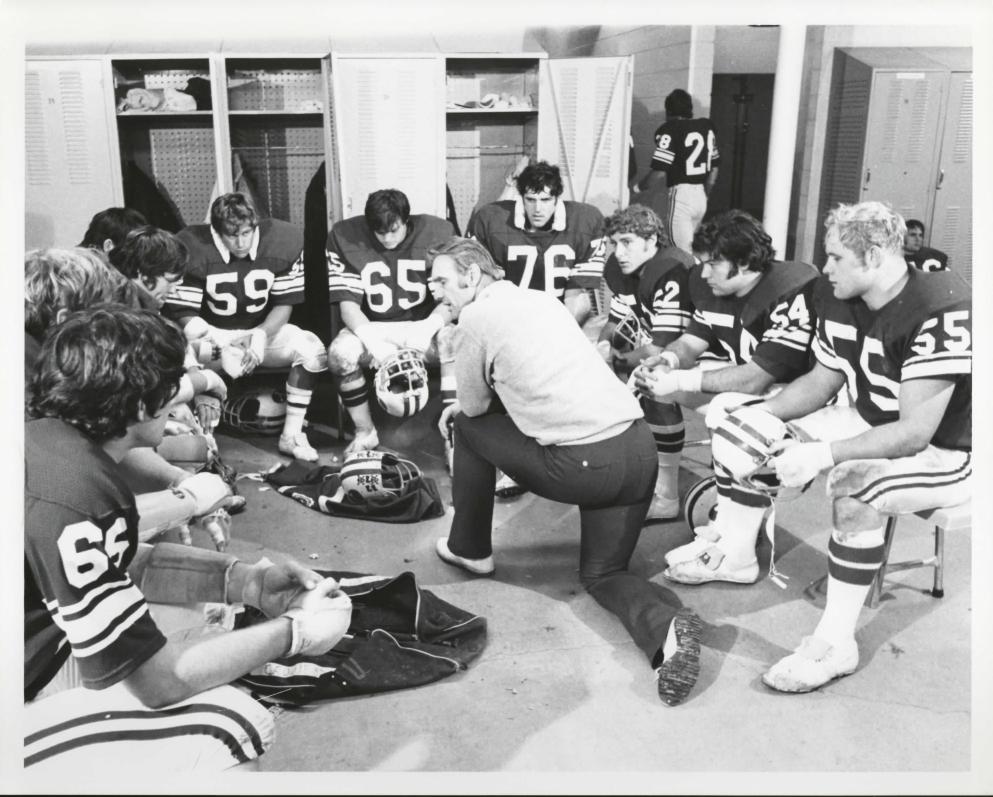Utah State’s ties to the BYU passing game — A conversation with Dave Kragthorpe
On Oct. 1, BYU defeated Utah State 34-20 to claim the Old Wagon Wheel rivalry trophy.
Displayed in the matchup between the two modern offenses were dynamic, no-huddle schemes which rely heavily on the passing attack. Utah State threw the ball 48 times, completing 26 passes for 314 yards. BYU threw the ball 29 times, completing 21 passes for 245 yards.
It was a game that looked commonplace to other games in college football. But it’s a stark contrast from the offensive styles of the past. From a “three yards and a cloud of dust,” single-wing offense, to explosive air-raid attacks, football has completely changed over the past 50 years.
And it’s an evolution with direct ties to the Old Wagon Wheel rivalry. Several of the individuals who directly fostered the advancement of the passing attack have close personal ties to both Utah State and BYU.
Dave Kragthorpe, who is a member of the Utah State Athletics Hall-of-Fame, former Utah State player and athletic director, as well as a former BYU offensive coordinator, is one of these individuals.
In an hour-long interview with 88-year old Kragthorpe, he generously shared with me how his relationship with his former Aggie teammate LaVell Edwards developed over the years, and how the passing game progressed with it.
***
The heart of the story begins 50 years ago.
After the 1971 season, BYU went 5-6, and Head Coach Tommy Hudspeth was fired. Promoted to the head coaching position was Edwards.
Few would have anticipated what was to come. Edwards would be the Cougar head coach for the next 29 seasons, compiling a 257-101-3 record, coaching a Heisman Trophy winner in Ty Detmer in 1990 and winning a National Championship in 1984. And along the way, he’d become known as an offensive icon who changed the sport.
But according to Kragthorpe, who was the offensive coordinator at BYU from 1970 to 1979, Edwards himself wasn’t much of an offensive guru.
“LaVell Edwards was a personal friend, and a wonderful person, I don’t want to discredit him,” Kragthorpe said. “If you’re in charge of a program by name, whether it’s football, basketball, or baseball or whatever else, if successful, you are the one who is going to get the credit. And so the football program belonged to LaVell Edwards, no question about that. But was he responsible for the pass offense? No.”
Edwards, who played at Utah State, was originally a defensive coordinator at BYU.
“He was defensive-minded, defensive-oriented, defensive experienced,” Kragthorpe said. “And yet in the final analysis, now and in retrospect, they look at LaVell as the one who orchestrated or invented the BYU offense.”
What Edwards did do — beyond lead the program — is bring in three different passing-minded quarterback coaches throughout the 1970s: Dewey Warren, Dwain Painter and Doug Scovil
. With the help of Kragthorpe, these coaches would help establish BYU’s dominating passing attack.
***
Hailing from Minnesota, an 18-year-old Kragthorpe received a full scholarship from Utah State and moved out to Logan in the summer of 1951.
He picked an ideal time to be a freshman in amateur athletics. Due to the ongoing Korean War, the NCAA allowed freshmen the opportunity to play at the varsity level. Starting his first game in an Aggie uniform, Kragthorpe was an offensive tackle who made an immediate impact.
One of his teammates happened to be Edwards, who was a senior.
“First of all, we were on a different page because he was married and I of course was a single 18-year-old freshman,” Kragthorpe said. “But we did develop a relationship that continued for life. We were close from that point on.”
Running the single-wing offense, the Aggies finished a mediocre 3-5-1 in 1951, including a 28-27 defeat in Provo against BYU. Though not a successful season, it was certainly impactful. It was the beginning of a 65-year friendship between Edwards and Kragthorpe.
“It was the beginning of that relationship that started us there and finally many years later it was the reason of course that I came to BYU.”

In the meantime, Edwards graduated from Utah State, and Kragthorpe remained an Aggie, where he started 40 consecutive games. Considered one of the greatest offensive linemen in Utah State history, Kragthorpe was a two-time all-Skyline Conference player.
While Kragthorpe was dominating the line of scrimmage, Edwards was beginning a coaching career. He coached at Granite High School in Salt Lake City, from 1954 to 1961, then became an assistant at BYU in 1962.
Following his college days, Kragthorpe would make his way up the coaching ladder as well. He made stops at Idaho Falls High School and Wyandotte High School in Michigan. In 1965, he received his first college coaching gig as an assistant at Montana. By 1969, he was a college head coach at South Dakota State.
The two former Aggies would stay in touch by linking up at the national coaching convention in January every year. Edwards, who was the BYU defensive coordinator, would always solicit Kragthorpe to come to BYU. In 1970, Edward’s prying paid off, and Kragthorpe left South Dakota State to be the offensive coordinator in Provo.
***
In 1972, Dewey Warren, a former Tennessee quarterback, became the quarterback coach at BYU. “The Swamp Rat,” as Warren is nicknamed in Tennessee circles, had NFL experience being on the Cincinnati Bengals and was known for tossing the pigskin. He got the BYU offense passing the football.
Quarterbacks Bill August and Dave Terry would combine for 1,633 passing yards over the course of the 1972 season. The running game was still a key feature. The team gained a combined 2,329 yards on the ground.
BYU would finish the season an improved 7-4. But in 1973, they regressed to 5-6. Warren would move on from the program. So they brought in Dwain Painter, who put “a different spin” on the passing game, according to Kragthorpe.
The Cougars were good under Painter, going 7-4-1 in 1974, and 6-5 in 1975. Quarterback Gary Sheide threw for 2,174 passing yards in 1974, and 217 Gifford Nielsen and Mark Giles would combine for 1,867 in 1975.
But, according to Kragthorpe, the dynamic passing offense which BYU became known for didn’t truly start to take form until 1976 when Painter left, and Doug Scovil was hired as the new quarterback’s coach.
Coming to Provo after six years as the quarterback coach for the San Francisco 49ers, Scovil came in and did things his own way.
“Doug Scovil brought the philosophy of pass first,” Kragthorpe said. “His philosophy calling the plays was that he would pass from any place on the field on any down. Meaning if we took the ball over on our two yard-line, I guarantee you the first play coming out of our two-yard line was a pass.”
Scovil dialed up simple routes that seemed to work “every time” according to Kragthorpe. And for the first time since Edwards was the head coach, the offense truly became formidable.
No doubt, Kragthorpe — who was entering his seventh year as offensive coordinator — played a major role. In charge of the pass protection and the run game, Kragthorpe has spent the past several years studying and perfecting the art of protecting the quarterback.
It wasn’t something he grew up learning. At Utah State, he wasn’t a part of a passing offense. And he didn’t facilitate much of one at his other stops either. So when BYU began to pass the football, Kragthorpe decided he needed to learn the ropes.
He traveled to the University of Tulsa, which was one of the more prolific passing schools at the time, to learn what they were doing and why they were so successful doing it. He found much of their success was rooted in their pass protection.
“That’s where I picked up the past protection schemes that I used for the rest of my coaching career. The University of Tulsa,” Kragthorpe said. “So a lot of the origin of the BYU passing game came from the University of Tulsa.”
Learning how to properly protect the passer was a key step in establishing what the BYU offense became known as.
“There’ve been lots of successful quarterbacks, but none of them threw very well playing on their back,” Kragthorpe quipped.

Dave Kragthorpe at BYU.
With the pass protection schemes, Scovil’s passing strategy and quarterback Gifford Nielsen’s abilities, the 1976 offense flourished.
During the 1976 season, Nielsen led the nation in passing yards (3401), passing touchdowns (30), and was second in completions (230) and attempts (406). BYU averaged 31 points per game — eighth in the nation, earned a trip to the Tangerine Bowl and finished 9-3. In 1977 they averaged a second-best 39.4 points per game and went 9-2.
“They couldn’t stop it because we had good pass protection, we had a good passer and good receivers and so there’s no secret about it, you gotta have those elements,” Kragthorpe said.
A Salt Lake Tribune story written in 2012 by Kragthorpe’s son, Kurt Kragthorpe, and Jay Drew, highlighted the simple yet effective nature of the BYU offense Scovil established.
“BYU’s passing offense is designed to stretch the field vertically and horizontally, using all five eligible receivers. It involves clear-our routes to create seams in the middle of the field for the tight end and flare patterns to the running backs. On each play, the quarterback goes from one potential receiver to another, based on timing, and taking what the defenses gives.”
“There’s no question in my mind, and I’ve always said it. Doug Scovil was responsible for the origin of the BYU pass offense,” Kragthorpe said. “Not LaVell Edwards, not Dave Kragthorpe. Doug Scovil. And so whatever we accomplished in the passing game, goes back to him.”

Kragthorpe credits Scovil for implementing the BYU passing game
***
The passing game was utilized at several other universities across the country in the ’80s, particularly on the west coast. This included San Diego State, UNLV, San Jose State and Utah.
The question is, did the BYU passing game have an impact on how Utah State played?
“I think so. Yeah,” said Kragthorpe. “Because we’ve had through the years they’ve been strong in the passing game, and that’s where they are today.”
Bruce Snyder became the head coach of the Aggies in 1976, they started to throw the football. It would soon pay dividends. In the 1978 season, Utah State went 7-4 and claimed a share of the Big West title.
The Aggies were led by quarterback Eric Hipple, who threw for 2088 passing yards, the 11th most in the nation. In 1979, he passed for a 17th-best 1924 and the Aggies went 8-2-1, once again claiming a share of the Big West title.
Over the years, several other Utah State quarterbacks have put up top-tier numbers nationally.
In 1980 quarterback Bob Gagliano took over the reins and passed for 2,365 yards, tenth in the nation. In 1987 quarterback Brent Snyder threw for an eighth-best 2,887 yards. In 1993, Anthony Calvillo threw for an 11th best 3,148 yards.
The 2021 Utah State team is currently 13th nationally in passing per game at 319.8. On Friday, they’ll face a BYU team coached by Kalani Sitake, who was coached by Edwards.
There are no direct ties from Head Coach Blake Anderson to Edwards, although Anderson did work for Provo-born Rocky Long at New Mexico.
There’s no question some of the schemes seen will look familiar to what Doug Scovil and the BYU offense put together in the late 1970s. Plays may just be run a little bit quicker, with more complexity and diversion.
Kragthorpe appreciates how the game has advanced over the years and is proud of the role he played in harboring change. He described his ten-year gig at BYU as “the best job I ever had.”
But make no mistake about it. Kragthorpe, who resides in Logan with his wife, Barb, is an Aggie, through and through.


Great article, but is it Doug Scovil or Doug Scobel? You interchange the two names.